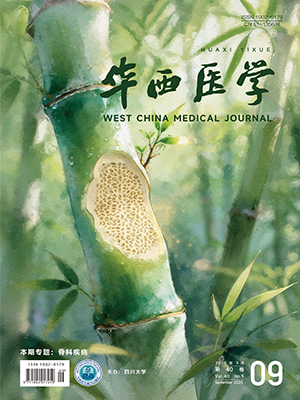| 1. |
尹進, 唐麗君, 高瓊, 等. 湖南省醫用超聲探頭表面及耦合劑微生物污染現況調查. 實用預防醫學, 2021, 28(11): 1394-1396.
|
| 2. |
費春楠, 蔡勃燕, 楊華明. 醫用超聲診療過程消毒的衛生學意義. 中國消毒學雜志, 2015, 32(9): 911-915.
|
| 3. |
辛昊, 楊子鑫, 朱梅. 醫用超聲探頭污染現狀及消毒方法進展. 中國消毒學雜志, 2023, 40(8): 621-625.
|
| 4. |
劉珍青, 李娜, 李彥珺. 消毒供應室的質量控制與醫院感染控制的研究. 實用臨床醫藥雜志, 2018, 22(18): 53-55.
|
| 5. |
李六億, 張流波, 姚楚水, 等. 醫療機構消毒技術規范//2014 年河南省護理學會醫院感染管理專業學術研討會論文集. 鄭州: 河南省護理學會醫院感染管理分會, 2014: 40.
|
| 6. |
林云萬, 張旭, 趙正陽, 等. 醫用超聲探頭及耦合劑微生物污染調查及分析. 中國消毒學雜志, 2023, 40(2): 106-108.
|
| 7. |
姚希, 鞏玉秀, 張宇, 等. 《醫療機構消毒技術規范》WS/T 367-2012 實施情況調查. 中國感染控制雜志, 2020, 19(8): 728-732.
|
| 8. |
郭愛香, 王素鳳, 喬海燕, 等. 某三甲醫院 B 超探頭微生物污染現況調查. 中華醫院感染學雜志, 2020, 30(2): 263-266.
|
| 9. |
上海市市場監督管理局. 醫用超聲探頭消毒衛生要求. 上海: 上海市市場監督管理局, 2022.
|
| 10. |
韓佳音, 林錦炎, 陳惠珍, 等. 一起剖宮產術后切口愈合不良事件流行病學調查. 中華醫院感染學雜志, 2014, 24(6): 1518-1520.
|
| 11. |
孫吉花, 宋洪芳, 樊國愛, 等. 洋蔥伯克霍爾德菌下呼吸道感染流行病學調查. 中華醫院感染學雜志, 2024, 34(18): 2828-2831.
|
| 12. |
肖姍, 羅美華, 歐新華. 某市醫療機構 B 超探頭微生物污染現狀分析. 中國消毒學雜志, 2017, 34(5): 480-482.
|
| 13. |
劉希茹, 段弘揚, 李濤, 等. 體外超聲探頭及陰道超聲探頭微生物污染現況調查. 中華醫院感染學雜志, 2020, 30(5): 775-779.
|
| 14. |
陳羽浩, 江飛, 劉劍橋, 等. B 超探頭消毒器在醫用超聲探頭表面消毒的應用研究. 實用預防醫學, 2019, 26(1): 101-102.
|
| 15. |
劉希茹, 沈瑾, 李濤, 等. 北京市體外超聲探頭及耦合劑微生物污染現況調查. 中國消毒學雜志, 2017, 34(4): 341-344.
|
| 16. |
Kanagala P, Bradley C, Hoffman P, et al. Guidelines for transoesophageal echocardiographic probe cleaning and disinfection from the British Society of Echocardiography. Eur J Echocardiogr, 2011, 12(10): i17-i23.
|
| 17. |
何榮攀, 李賢煌, 畢正琴, 等. 37 所醫院消化內鏡超聲探頭清洗消毒現況調查. 中國感染控制雜志, 2020, 19(12): 1059-1063.
|
| 18. |
Osterman MJ, Martin JA. Changes in cesarean delivery rates by gestational age: United States, 1996-2011. NCHS Data Brief, 2013(124): 1-8.
|
| 19. |
河北省藥物警戒中心. 河北省藥物警戒中心關于上報河北省醫療器械不良事件季度風險匯總分析的報告: 冀藥警戒〔2022〕6 號. 石家莊: 河北省藥物警戒中心, 2022.
|
| 20. |
劉欣欣, 閆玲, 趙一飛, 等. 陰道超聲探頭消毒與感染風險的調研及分析. 中國醫學裝備, 2022, 19(9): 162-167.
|
| 21. |
Moshkanbaryans L, Meyers C, Ngu A, et al. The importance of infection prevention and control in medical ultrasound. Australas J Ultrasound Med, 2015, 18(3): 96-99.
|
| 22. |
Hutchinson J, Runge W, Mulvey M, et al. Burkholderia cepacia infections associated with intrinsically contaminated ultrasound gel: the role of microbial degradation of parabens. Infect Control Hosp Epidemiol, 2004, 25(4): 291-296.
|
| 23. |
Carrico RM, Furmanek S, English C. Ultrasound probe use and reprocessing: results from a national survey among U.S. infection preventionists. Am J Infect Control, 2018, 46(8): 913-920.
|
| 24. |
Andolfo A, Maatoug R, Peiffer-Smadja N, et al. Emergency ward ultrasound: clinical audit on disinfection practices during routine and sterile examinations. Antimicrob Resist Infect Control, 2021, 10(1): 25.
|
| 25. |
Miyague AH, Mauad FM, Martins Wde P, et al. Ultrasound scan as a potential source of nosocomial and crossinfection: a literature review. Radiol Bras, 2015, 48(5): 319-323.
|
| 26. |
Lei H, Dong X, Li L, et al. Retrospective study of the etiology and risk factors of systemic inflammatory response syndrome after systematic transrectal ultrasound-guided prostate biopsy. Infect Drug Resist, 2020, 13: 3187-3193.
|
| 27. |
Karadenz YM, Kili? D, Kara Altan S, et al. Evaluation of the role of ultrasound machines as a source of nosocomial and cross-infection. Invest Radiol, 2001, 36(9): 554-558.
|
| 28. |
丁紅暉, 譚莉, 鄒明君, 等. 某三甲醫院超聲診斷儀微生物污染現況調查. 中華醫院感染學雜志, 2023, 33(16): 2545-2549.
|
| 29. |
Rutala WA, Weber DJ, Society for Healthcare Epidemiology of America. Guideline for disinfection and sterilization of prion-contaminated medical instruments. Infect Control Hosp Epidemiol. 2010. 31(2): 107-117.
|
| 30. |
M’Zali F, Bounizra C, Leroy S, et al. Persistence of microbial contamination on transvaginal ultrasound probes despite low-level disinfection procedure. PLoS One, 2014, 9(4): e93368.
|
| 31. |
Casalegno JS, Le Bail Carval K, Eibach D, et al. High risk HPV contamination of endocavity vaginal ultrasound probes: an underestimated route of nosocomial infection?. PLoS One, 2012, 7(10): e48137.
|
| 32. |
Ding DC, Chang YC, Liu HW, et al. Long-term persistence of human papillomavirus in environments. Gynecol Oncol, 2011, 121(1): 148-151.
|
| 33. |
國家食品藥品監督管理總局. 醫用超聲耦合劑. 北京: 國家食品藥品監督管理總局, 2016.
|
| 34. |
國家藥品監督管理局. 醫用超聲耦合劑. 北京: 國家食品藥品監督管理總局, 2022.
|
| 35. |
湖南省質量技術監督局. 醫用超聲探頭表面消毒要求與效果評價方法. 長沙: 湖南省質量技術監督局, 2017.
|
| 36. |
經食道超聲心動圖臨床應用的中國專家共識專家組. 中國經食道超聲心動圖探頭清洗消毒指南. 中國循環雜志, 2020, 35(5): 419-426.
|
| 37. |
劉思娣, 豆清婭, 易亮, 等. 探討不同消毒方法對超聲探頭消毒效果的影響. 中國感染控制雜志, 2019, 18(9): 854-858.
|
| 38. |
SMFM Patient Safety and Quality Committee. Society for Maternal-Fetal Medicine Special statement: reducing the risk of transmitting infection by transvaginal ultrasound examination. Am J Obstet Gynecol, 2020, 223(3): B2-B6.
|
| 39. |
Canadian Society of Diagnostic Medical Sonography. Professional practice guidelines and policy statements for Canadian sonography. Ottawa: Canadian Society of Diagnostic Medical Sonography, 2014.
|
| 40. |
American Institute of Ultrasound in Medicine. AIUM official statement: guidelines for cleaning and preparing external- and internal-use ultrasound transducers and equipment between patients as well as safe handling and use of ultrasound coupling gel. J Ultrasound Med, 2023, 42(7): E13-E22.
|
| 41. |
Australasian Sonographers Association. Disinfection of intracavity ultrasound transducers. Melbourne: Australasian Sonographers Association, 2012.
|
| 42. |
Agência Nacional de Vigilancia Sanitaria. Manual de limpeza e desinfecaode aparelhos endoscópicos. Brasil: Agência Nacional de Vigilancia Sanitaria, 2013.
|
| 43. |
劉希茹, 張流波. 醫用超聲診療過程中的衛生現況及消毒進展. 中國消毒學雜志, 2017, 34(5): 468-472.
|
| 44. |
唐倩, 胡姚佳, 朱麗輝. 消毒濕巾臨床應用研究進展. 中國消毒學雜志, 2021, 38(3): 221-225.
|
| 45. |
Muradali D, Gold WL, Phillips A, et al. Can ultrasound probes and coupling gel be a source of nosocomial infection in patients undergoing sonography? An in vivo and in vitro study. AJR Am J Roentgenol, 1995, 164(6): 1521-1524.
|
| 46. |
Bello TO, Taiwo SS, Oparinde DP, et al. Risk of nosocomial bacteria transmission: evaluation of cleaning methods of probes used for routine ultrasonography. West Afr J Med, 2005, 24(2): 167-170.
|
| 47. |
Colandrea NA, Cleary ML, Peaper DR, et al. Oxygen nipple and nut (Christmas tree) adaptor contamination rates and decontamination with disinfecting wipes. Infect Control Hosp Epidemiol, 2020, 41(4): 396-399.
|
| 48. |
賈巍, 傅虹, 艾山江·哈得爾, 等. 復合雙鏈季銨鹽消毒濕巾對 B 超探頭的消毒效果研究//中華預防醫學會消毒分會 2014 年學術年會論文. 合肥: 中華預防醫學會消毒分會, 2014: 157-159.
|
| 49. |
柏榮華, 張冰, 康海全, 等. 一種濕巾對醫用超聲探頭消毒效果及耦合劑帶菌量的觀察. 中國消毒學雜志, 2020, 37(10): 727-729.
|
| 50. |
Koibuchi H, Fujii Y, Kotani K, et al. Degradation of ultrasound probes caused by disinfection with alcohol. J Med Ultrason (2001), 2011, 38(2): 97-100.
|
| 51. |
Mizuide M, Ryozawa S, Fujita A, et al. Complications of endoscopic ultrasound-guided fine needle aspiration: a narrative review. Diagnostics (Basel), 2020, 10(11): 964.
|
| 52. |
Ejtehadi F, Ejtehadi F, Teb JC, et al. A safe and practical decontamination method to reduce the risk of bacterial colonization of ultrasound transducers. J Clin Ultrasound, 2014, 42(7): 395-398.
|
| 53. |
Gray RA, Williams PL, Dubbins PA, et al. Decontamination of transvaginal ultrasound probes: review of national practice and need for national guidelines. Clin Radiol, 2012, 67(11): 1069-1077.
|
| 54. |
高宇, 李喆, 楚娜, 等. 綜合性醫院經食管超聲心動圖探頭的感控管理實踐. 山西醫藥雜志, 2022, 51(14): 1658-1660.
|
| 55. |
譚莉, 彭威軍, 范允舟. 不同消毒措施對 B 超探頭消毒效果觀察. 中國消毒學雜志, 2018, 35(8): 576-577, 580.
|
| 56. |
Chen GQ, Chen YH, Yi L, et al. Study on a new ultraviolet sterilizer to the surface disinfection of the ultrasound probe. Biomed Environ Sci, 2018, 31(2): 163-167.
|
| 57. |
深圳市華上醫療技術有限公司. 一種雙氧水與紫外燈結合的超聲探頭消毒裝置: CN202110095394.3. 2021-05-14.
|
| 58. |
Merz E. Is transducer hygiene sufficient when vaginal probes are used in the clinical routine?. Ultraschall Med, 2016, 37(2): 137-139.
|
| 59. |
Kyriacou C, Robinson E, Barcroft J, et al. Time-effectiveness and convenience of transvaginal ultrasound probe disinfection using ultraviolet vs chlorine dioxide multistep wipe system: prospective survey study. Ultrasound Obstet Gynecol, 2022, 60(1): 132-138.
|
| 60. |
孟偉, 王若蛟, 呂珂, 等. COVID-19 疫情期間非隔離診區超聲設備的消毒. 基礎醫學與臨床, 2020, 40(9): 1261-1265.
|
| 61. |
Frazee BW, Fahimi J, Lambert L, et al. Emergency department ultrasonographic probe contamination and experimental model of probe disinfection. Ann Emerg Med, 2011, 58(1): 56-63.
|




